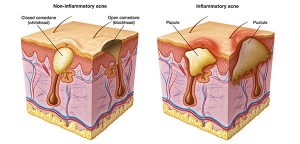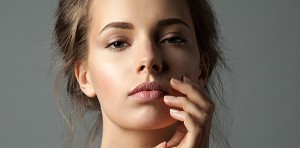How to treat acne
How to treat acne is by finding the cause(s). Read on for the list, how to test, treat, get results. Also, we cover how to know if it’s acne or something else right here. Oil (sebum) in our skin is made by sebaceous glands that reside in our hair follicles. When cellular debris blocks pores, the sebum becomes trapped. Bacteria feed on sebum then multiply.
The result is a comedone.
Click here to find out more about acne treatment options for:
- Bacteria management – increase recovery rate and improve wound healing
- Acne Scarring – linked to collagen depletion in the area of the acne lesion
- Post Inflammatory Hyperpigmentation – Linked to trauma of the acne lesion as melanocytes become activated in the immune process.
Acne and skin problems may not be life-threatening, but they’re associated with depression, anxiety, and social isolation.
Types of Acne
Types of Acne
How to treat acne
Inflammatory Acne
Papules: Pink or red bumps without a white or yellow centre.
Pustules: Red bumps with a white or yellow centre of pus. Pustules are formed when the plug inside a pore traps oil and bacteria, which draws white blood cells to the area to fight infection. Pus is made up of dead white blood cells.
Cysts and nodules: Larger (and often painful) acne lesions that extend into the deeper skin layers. Cysts and nodules can last for months, destroy the follicle and lead to permanent scars.
Non-Inflammatory Acne
Blackheads and whiteheads (aka open and closed comedones) occur when a plug made up of sebum and dead skin cells can be seen inside a follicle (pore), but does not cause any inflammation or redness.
Blackheads: If the plug enlarges and stretches the pore, it is referred to as a blackhead. Blackheads aren’t trapped dirt. Rather, the dark colour is a build-up of melanin and oxidised oil.
Whiteheads: When a thin cover of skin traps the plug, it prevents the oil from oxidising. This keeps it white and creates a whitehead.
Teen Acne vs Adult Acne
Adult skin is different than teenage skin. It produces less oil, has a slower rate of cell turnover, and heals at a different rate. Products designed for teenage skin are often too harsh for adults, so using them can lead to irritation and dryness. At the same time, adults are concerned with visible signs of ageing like fine lines, wrinkles and uneven skin tone.
Select products formulated with both specified adult acne and teen acne in mind.
Does the Gut-Brain-Skin Axis hold the secret to naturally get rid of acne? Receive your specific nutritional needs for long-term skin health goals.
How to fix hormonal acne
The enzyme 5-alpha reductase plays a vital role in the production of sebum and is directly affected by hormones. Acne treatment cream and options likes using acne treatment roaccutane come with informed choices at Susannah Makram Clinics and careful instructions for use. This is in combination with targeted, goal driven nutrition for skin.
Women often experience fluctuating hormone levels around the time of their periods, during pregnancy and in the years surrounding menopause. Switching or stopping birth control pills also causes hormonal changes.
Acne treatment for men
Men’s skin and male grooming in particular needs special care. Men can have mores sensitive skin.The epidermal barrier is a highly organised tissue. It responds efficiently and rapidly to the changing environment in order to maintain a state of balance.
Testosterone increases oil secretion all over the body, as is particularly evident on the face. By adulthood, most men normalise their oil production so acne isn’t a life-long skin problem. However, factors including cellular and immune function, are also major players in the development of acne.Shaving greatly increases the risk of UV damage and premature ageing.


